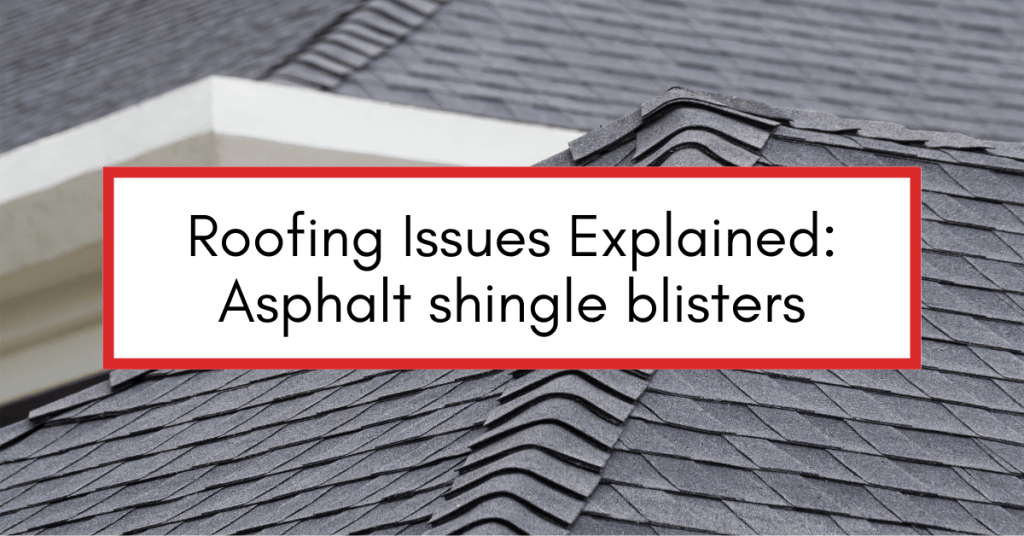Asphalt shingle blisters are a common roofing issue that homeowners may encounter, but many don’t fully understand the risks they pose. At AIC Roofing & Construction, we aim to educate homeowners about common roofing issues so they can confidently make informed decisions about their homes. In this article, we’ll explore what asphalt shingle blisters are, what causes them, their impact on your roof, and how to prevent and treat them.
What are Asphalt Shingle Blisters?
Asphalt shingle blisters are raised, bubble-like formations that develop on the surface of your shingles. These blisters can vary in size and are usually filled with air or moisture. Though they might appear to be a cosmetic concern, asphalt shingle blisters can indicate underlying issues with your roof that require attention.
To identify blisters, simply inspect your roof. Look for rounded, raised spots on the shingles. The size and severity of the blisters can range from small bubbles to larger, more noticeable protrusions.
Causes of Shingle Blisters
Several factors contribute to the formation of asphalt shingle blisters. While some may result from manufacturing defects, others are caused by environmental conditions. Understanding the causes can help prevent and address this issue.
Manufacturing Defects
In some cases, asphalt shingle blisters are the result of manufacturing defects. These can include improper blending of materials, inadequate sealing, or poor bonding during the production process. Without rigorous quality control, defective shingles may make it to the consumer, increasing the risk of blistering over time.
Environmental Factors
Environmental conditions, particularly heat and humidity, can also contribute to blister formation. When shingles are exposed to high temperatures, they expand, trapping air or moisture within their layers, which leads to blistering. Lack of proper roof ventilation exacerbates this issue, as the shingles are unable to regulate their temperature effectively.
UV radiation from the sun, along with frequent temperature fluctuations, can also weaken asphalt shingles over time, making them more susceptible to blistering.
The Impact of Shingle Blisters on Your Roof
While asphalt shingle blisters may initially seem like a minor issue, they can have significant long-term effects on your roof’s performance and appearance.
Structural Damage
Blisters can compromise the integrity of your shingles, making them more prone to leaks and water damage. The raised areas create an uneven surface that increases the risk of wind damage and premature wear. Over time, the blisters can worsen, leading to more serious issues, such as water infiltration and mold growth, especially in extreme weather conditions.
Aesthetic Implications
From a visual perspective, asphalt shingle blisters can detract from your roof’s curb appeal. If left untreated, these blisters can become more prominent, which may reduce your home’s overall aesthetic value. This could also affect the resale value of your property, should you decide to sell in the future.
Prevention and Treatment
The good news is that with the right prevention and treatment, you can minimize the impact of shingle blisters on your roof.
Regular Roof Maintenance:
-
Conduct regular roof inspections to spot signs of damage or wear.
-
Address issues promptly to prevent further damage.
-
Ensure proper attic ventilation to regulate temperature and humidity.
-
Prevent overheating and moisture buildup, which can lead to blistering.
FAQs: Shingle Blisters
Are Shingle Blisters Covered by Warranty?
The coverage for asphalt shingle blisters varies depending on the warranty terms provided by the manufacturer. Some warranties may cover blisters caused by manufacturing defects, while others may not cover blisters resulting from improper installation or environmental factors. It’s essential to review your warranty documentation to determine your coverage options.
Can I Fix Shingle Blisters Myself?
While DIY repairs may seem tempting, it’s generally best to leave blister repairs to the professionals. Roofing repairs require specific knowledge and skills to ensure proper installation and prevent further damage. A roofing expert can diagnose the underlying causes of the blisters and implement effective solutions to fix them properly.
Expert Roof Repair and Replacement in Central Kentucky and Cincinnati
Understanding asphalt shingle blisters is vital for homeowners dealing with common roofing issues. By identifying blisters early, addressing their causes, and taking preventative measures, you can maintain your roof’s integrity and appearance. If you’re concerned about asphalt shingle blisters or other roofing issues, don’t hesitate to reach out to a professional roofing contractor for guidance and assistance.
If you have concerns about your roof, contact us for a free, no-obligation roof inspection today!
